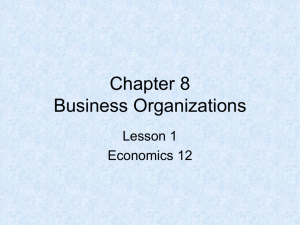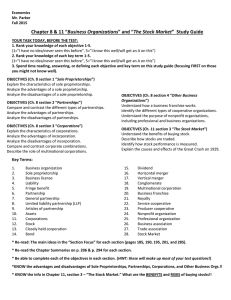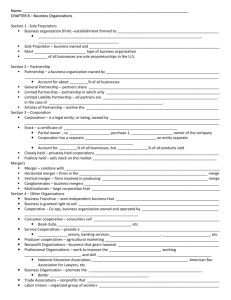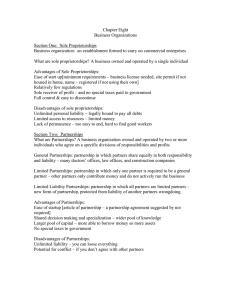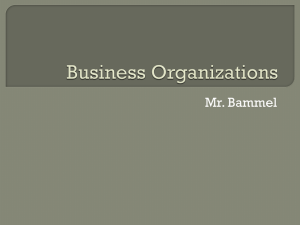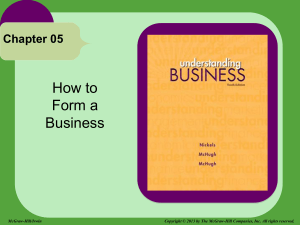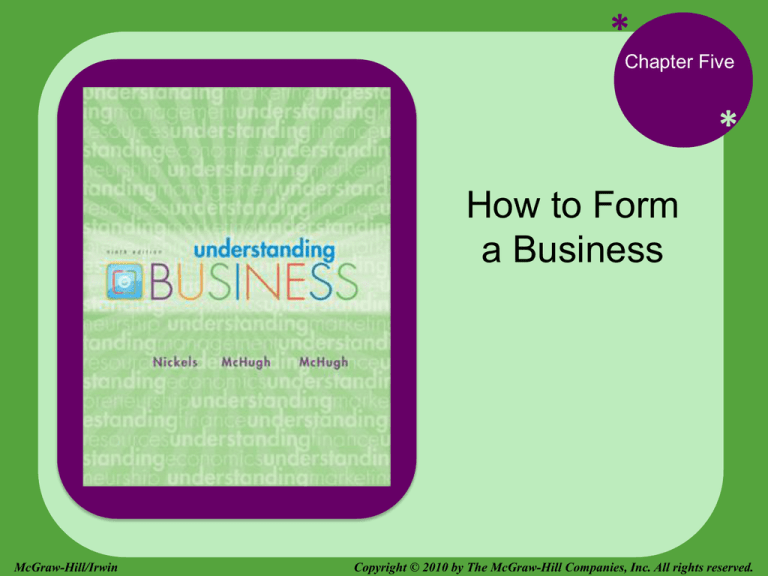
*
Chapter Five
*
How to Form
a Business
McGraw-Hill/Irwin
Copyright © 2010 by The McGraw-Hill Companies, Inc. All rights reserved.
FORMS of
BUSINESS OWNERSHIP
*
Basic Forms of
Business
Ownership
LG1
*
5-2
MAJOR BENEFITS of SOLE
PROPRIETORSHIP
*Advantages of
Sole
Proprietorships
LG1
*
• Ease of starting and
ending the business
• Being your own boss
• Pride of ownership
• Leaving a legacy
• Retention of company
profit
• No special taxes
5-3
DISADVANTAGES of SOLE
PROPRIETORSHIPS
*Disadvantages
of Sole
Proprietorships
LG1
*
• Unlimited Liability -- Any debts or damages
incurred by the business are your debts, even if it
means selling your home, car or anything else.
• Limited financial resources
• Management difficulties
• Overwhelming time commitment
• Few fringe benefits
• Limited growth
• Limited life span
5-4
*
MAJOR TYPES of PARTNERSHIPS Partnerships
• General Partnership -- All owners share in
LG2
*
operating the business and in assuming liability for
the business’s debts.
• Limited Partnership -- A partnership with one or
more general partners and one or more limited
partners.
5-5
ADVANTAGES of
PARTNERSHIPS
*
Advantages &
Disadvantages
of Partnerships
LG2
*
• More financial resources
• Shared management and
pooled skills and
knowledge
• Longer survival
• No special taxes
5-6
DISADVANTAGES of
PARTNERSHIPS
*
Advantages &
Disadvantages
of Partnerships
LG2
*
• Unlimited liability
• Division of profits
• Difficult to terminate
• Disagreements among
partners
5-7
CONVENTIONAL
CORPORATIONS
*
Corporations
LG3
*
• Conventional (C)
Corporation -- A statechartered legal entity with
authority to act and have
liability separate from its
owners (its stockholders).
5-8
*
TYPES of MERGERS
Corporate
Expansion:
Mergers and
Acquisitions
LG4
*
• Vertical Merger -- Joins two firms in different
stages of related business.
• Horizontal Merger -- Joins two firms in the same
industry and allows them to diversify or expand their
products.
• Conglomerate Merger -- Unites firms in
completely unrelated industries in order to diversify
business operations and investments.
5-9
*
FRANCHISING
Franchises
LG5
*
• Franchise Agreement -- An arrangement whereby
someone with a good idea for a business
(franchisor) sells the rights to use the business
name and sell a product or service (franchise) to
others (franchisees) in a given territory.
• More than 900,000 franchised businesses
operate in the U.S., employing approximately 10
million people.
5-10
ADVANTAGES of FRANCHISING
*Advantages &
Disadvantages
of Franchises
LG5
*
• Management and marketing
assistance
• Personal ownership
• Nationally recognized name
• Financial advice and
assistance
• Lower failure rate
5-11
DISADVANTAGES of
FRANCHISING
*Advantages &
Disadvantages
of Franchises
LG5
*
• Large start-up costs
• Shared profit
• Management regulation
• Coattail effects
• Restrictions on selling
• Fraudulent franchisors
5-12
*
COOPERATIVES
Cooperatives
LG6
*
• Cooperatives -- Businesses owned and controlled
by the people who use it – producers, consumers, or
workers with similar needs who pool their resources
for mutual gain.
• Worldwide, 750,000 cooperatives serve 730
million members – 120 million in the U.S.
• Members democratically control the business by
electing a board of directors that hires
professional management.
5-13

